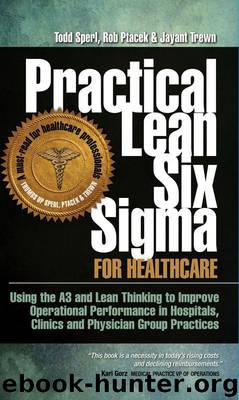Practical Lean Six Sigma for Healthcare (with Links to over 30 Excel Worksheets): Using the A3 and Lean Thinking to Improve Operational Performance in ... Clinics, and Physician Group Practices by Trewn Jayant & Ptacek Rob & Sperl Todd

Author:Trewn, Jayant & Ptacek, Rob & Sperl, Todd [Trewn, Jayant]
Language: eng
Format: epub
Publisher: MCS Media, Inc.
Published: 2014-05-12T16:00:00+00:00
Process Capability
The best way to escape from a problem is to solve it.
Alan Saporta
What is it?
Process Capability analysis is used to determine if a process, given its natural process variation in a stable state, is capable of meeting customer specifications or requirements. Determining process stability is done by monitoring a process output over time, using Run Charts and/or Statistical Process Control. True improvement in a process is achieved by balancing stability with the capability of meeting customer requirements, otherwise known as process capability.
What does it do?
The definitions and formulas for process average, range, and standard deviation are used to estimate process capability and are as follows:
Process Average = Mean = X-Bar = Sum of all data points / Number of data points
Range = R = Difference between the largest and smallest data point
Standard Deviation (SD) = Root Mean Square (RMS) =
σ = [Sum of ((X- X-bar)² / Number of data points)]½
Process capabilities are calculated as follows:
Cp = Process Capability = Tolerance Range / 6 σ
Cpu = Process capability to the upper tolerance limit = (Upper Tolerance Limit – Process Average) / 3 σ
Cpl = Process capability to the lower tolerance limit = (Process Average- Lower Tolerance limit) / 3 σ
Cpk = the lower of Cpu or Cpl = (Closest Specification Limit to Process Average – Process Average) / 3 σ
Estimates of long term process capability are best predicted by the Cpk value. Cpk considers both the process spread (σ) and the process centering to specification nominal. The standard deviation (SD) representing the process variation is proportional to the overall process spread. A process being 6σ or 6σ capable means that ± 6σ process width falls within the specifications or tolerance limits, as illustrated in the diagram below:
Download
This site does not store any files on its server. We only index and link to content provided by other sites. Please contact the content providers to delete copyright contents if any and email us, we'll remove relevant links or contents immediately.
Hit Refresh by Satya Nadella(9038)
The Compound Effect by Darren Hardy(8808)
Change Your Questions, Change Your Life by Marilee Adams(7635)
Nudge - Improving Decisions about Health, Wealth, and Happiness by Thaler Sunstein(7615)
The Black Swan by Nassim Nicholas Taleb(7010)
Deep Work by Cal Newport(6879)
Daring Greatly by Brene Brown(6445)
Rich Dad Poor Dad by Robert T. Kiyosaki(6401)
Principles: Life and Work by Ray Dalio(6211)
Man-made Catastrophes and Risk Information Concealment by Dmitry Chernov & Didier Sornette(5921)
Playing to Win_ How Strategy Really Works by A.G. Lafley & Roger L. Martin(5920)
Digital Minimalism by Cal Newport;(5664)
Big Magic: Creative Living Beyond Fear by Elizabeth Gilbert(5610)
The Myth of the Strong Leader by Archie Brown(5425)
The Slight Edge by Jeff Olson(5346)
Discipline Equals Freedom by Jocko Willink(5285)
The Motivation Myth by Jeff Haden(5156)
Stone's Rules by Roger Stone(5026)
The Laws of Human Nature by Robert Greene(4998)
